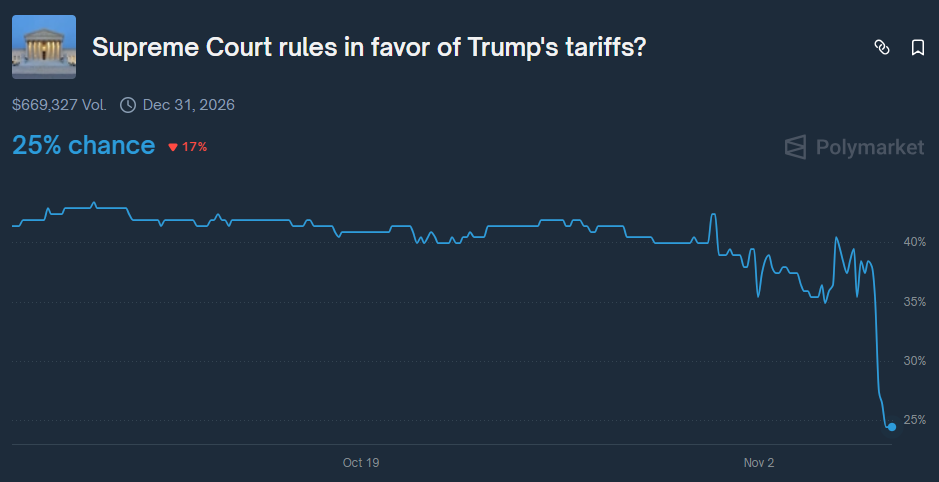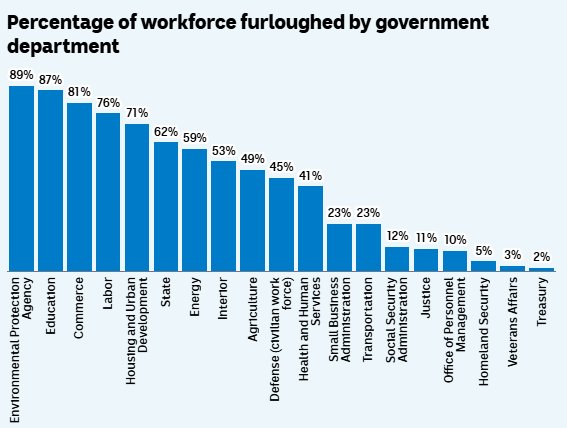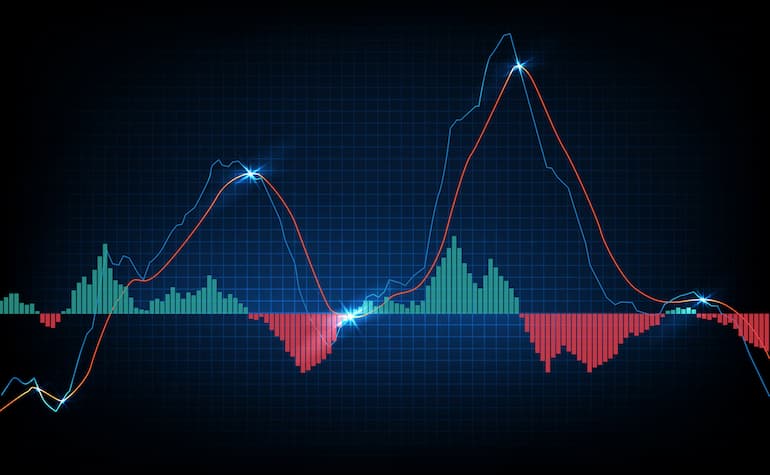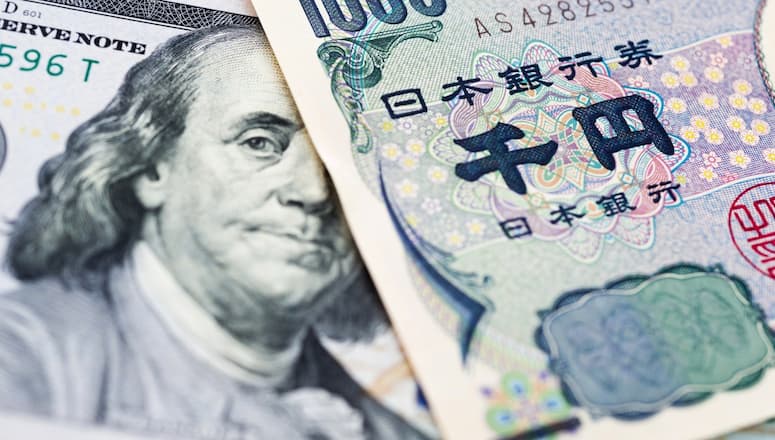Berita & analisis pasar
Tetap selangkah lebih maju di pasar dengan wawasan ahli, berita, dan analisis teknikal untuk memandu keputusan trading Anda.

Artificial intelligence stocks have begun to waver slightly, experiencing a selloff period in the first week of this month. The Nasdaq has fallen approximately 2%, wiping out around $500 billion in market value from top technology companies.

Palantir Technologies dropped nearly 8% despite beating Wall Street estimates and issuing strong guidance, highlighting growing investor concerns about stretched valuations in the AI sector.
Nvidia shares also fell roughly 4%, while the broader selloff extended to Asian markets, which experienced some of their sharpest declines since April.
Wall Street executives, including Morgan Stanley CEO Ted Pick and Goldman Sachs CEO David Solomon, warned of potential 10-20% drawdowns in equity markets over the coming year.
And Michael Burry, famous for predicting the 2008 housing crisis, recently revealed his $1.1 billion bet against both Nvidia and Palantir, further pushing the narrative that the AI rally may be overextended.
As we near 2026, the sentiment around AI is seemingly starting to shift, with investors beginning to seek evidence of tangible returns on the massive investments flowing into AI, rather than simply betting on future potential.
However, despite the recent turbulence, many are simply characterising this pullback as "healthy" profit-taking rather than a fundamental reassessment of AI's value.
Supreme Court Raises Doubts About Trump’s Tariffs
The US Supreme Court heard arguments overnight on the legality of President Donald Trump's "liberation day" tariffs, with judges from both sides of the political spectrum expressing scepticism about the presidential authority being claimed.
Trump has relied on a 1970s-era emergency law, the International Emergency Economic Powers Act (IEEPA), to impose sweeping tariffs on goods imported into the US.
At the centre of the case are two core questions: whether the IEEPA authorises these sweeping tariffs, and if so, whether Trump’s implementation is constitutional.
Chief Justice John Roberts and Justice Amy Coney Barrett indicated they may be inclined to strike down or curb the majority of the tariffs, while Justice Brett Kavanaugh questioned why no president before Trump had used this authority.
Prediction markets saw the probability of the court upholding the tariffs drop from 40% to 25% after the hearing.

The US government has collected $151 billion from customs duties in the second half of 2025 alone, a nearly 300% increase over the same period in 2024.
Should the court rule against the tariffs, potential refunds could reach approximately $100 billion.
The court has not indicated a date on which it will issue its final ruling, though the Trump administration has requested an expedited decision.
Shutdown Becomes Longest in US History
The US government shutdown entered its 36th day today, officially becoming the longest in history. It surpasses the previous 35-day record set during Trump's first term from December 2018 to January 2019.
The Senate has failed 14 times to advance spending legislation, falling short of the 60-vote supermajority by five votes in the most recent vote.
So far, approximately 670,000 federal employees have been furloughed, and 730,000 are currently working without pay. Over 1.3 million active-duty military personnel and 750,000 National Guard and reserve personnel are also working unpaid.

SNAP food stamp benefits ran out of funding on November 1 — something 42 million Americans rely on weekly. However, the Trump administration has committed to partial payments to subsidise the benefits, though delivery could take several weeks.
Flight disruptions have affected 3.2 million passengers, with staffing shortages hitting more than half of the nation's 30 major airports. Nearly 80% of New York's air traffic controllers are absent.
From a market perspective, each week of shutdown reduces GDP by approximately 0.1%. The Congressional Budget Office estimates the total cost of the shutdown will be between $7 billion and $14 billion, with the higher figure assuming an eight-week duration.
Consumer spending could drop by $30 billion if the eight-week duration is reached, according to White House economists, with potential GDP impacts of up to 2 percentage points total.


What is going on with Tesla’s share price? Tesla is now one of the world’s most recognisable brands and companies. A leader in technology and pioneer of the electric vehicle space.
The company has become a beacon of hope for the charge against climate change and move towards a more a carbon friendly future. At the centre of the company is its CEO, South African born billionaire, and visionary Elon Musk. Musk, who famously took over Twitter last year and has a list of other ventures including SpaceX, the Boring project and Starlink is a polarising figure with his controversial tweet comments and stances.
This at times has hurt Tesla’s share price and reputation. However, he has been bold and aggressive in his plans and hopes for Tesla. However, the company’s share price has taken a massive hit in the prior 18 month after peaking at $414.
The price has now fallen back to $117 and is down 71.5% from those highs. The reason for the drop is due to various reason, Musk’s own hubris, a tough environment for growth company’s and missed deadlines. However, is the current state a once in a lifetime opportunity to enter a generational company at a heavy discount or a sign of big change in fortunes for the company.
The numbers The company’s share price has been dropping rapidly as production has slowed worries over the company’s ability to keep up with demand or worse the slowing of demand has spooked the market to the ability for the company to continue to grow. Furthermore, concern has developed over whether its first mover advantage is starting to fall away. Other car manufacturers are beginning to develop and get to market their own electric vehicles threatening Tesla’s market share.
In saying this, Tesla still managed to sell 1.3 million vehicles last year short of the Musk’s 50% growth target. The company also manufactured 1.37 million cars for the 2022 calendar year. The company also increased its revenue to 74.836 billion dollars from 53.823 billion for the prior financial year.
Tesla also has a notoriously high Price/Earnings ratio even when compared to most other car manufacturers. Top car manufacturers such as Toyota, Volkswagen and Ford have much more modest PE ratios then Tesla has. Therefore, it is possible that the market is just valuing the company alongside the industry standard.
In addition, the company still has a market capitalisation of almost double that of Toyota and significantly higher than other manufacturers. Company PE Ratio BMW 3.11 Volkswagen 4.14 Toyota 9.19 Ford 5.70 Tesla 31.3 Price Action analysis The price chart for Tesla is not particularly encouraging. The price is at levels not seen in more than 2 and a half years.
The price is currently at $120 USD and has not yet made a bottom. In fact, the price has fallen below its 200-week moving average a bearish sign. It is resting on a support region at 110-120 dollars and if it fails its next support is at $65.
The volume of selling has been quite aggressive. At this stage until, there is some sort of support or buying volume it remains a more favorable short then long. However, if the price can find support at $110 it may bounce and begin a reversal.
Ultimately, Tesla remains an intriguing opportunity for traders and investors. With high volatility and a high growth runway, Tesla may provide a rare opportunity for a long time.


The Aussie dollar has been on a tear in recent weeks as a weaker USD and thoughts of a pivot in US interest rate hikes has seen the Aussie bounce from its lows near $0.62. The Australian dollar and economy have benefited from the improved strength in commodity prices such as Gold and Iron ore which are important players in Australia’s economy. In addition, a potential reopening of China and improved economic prospects for the country means that it may be protected in the case of a global recession.
The long-term price action of the AUSUSD is that of a ranging pattern. Since 2015 there has been no consistent trend. The price dropped to near $0.60 during the initial stages of Covid 19 and in October last year.
The price has now recovered almost 12% from this October bottom and has shown a strong rejection of the $0.62 zone. The strength of the support can be seen by the weekly buying candle. This is almost identical to the pattern that occurred when the price bounced in 2020 categorised by a long green body and short wick.
In 2020, the price then rose to $0.79. This is a reasonable longer-term target especially if the USD continues to weaken. The one concern is the resistance level at $0.70.
This level is middle of the range of the pair’s price and could act as a difficult area to profit on the price action. Therefore, it would be best to wait for a confirmation candle either short or long before entering into a position. On the daily time frame, the price has just risen above the 200-day moving average and the 50-day moving average has begun to trend back upward and potentially cross back above the longer time moving average.
This may provide a buy signal if it occurs. The RSI is also consolidating and if it breaks out of its wedge, it may provide an indication of a further move to the upside. With so much more data to come still relating to inflation data and broader economic data, there may still be some volatility in the direction of the AUDUSD.


The JPY had seen some renewed strength after the Bank of Japan finally intervened late in 2022 to widen its target band on its 10-year band to -0.5-0.5% from -0.25-0.25%. This was seen as an overall positive catalyst for the currency and a sign that the Bank may be ready to increase rates. The question that remains is will the market trust the BOJ and continue buying the JPY or is the buying just an opportunity for shorters to enter.
Whilst potential trades exist on most of the JPY pairs, the most promising trade is on the CHFJPY. Technical Analysis The weekly price chart shows an interesting pattern forming. The price initially sold down quite heavily when the BOJ announced its intervention.
The price sold down aggressively but has not been able to pass through the 139.00 level. This support level acts as both the 50-week moving average and a long-term support level. This explains the initial price rejection.
The bounce was emphasised by the candlestick and the length of its wick. The body of the candle is very small and the wick long, highlighting how buyers immediately soaked up the selling potentially creating a pivot point. The daily chart is less encouraging, it still shows the price in a down trend.
Although, there was a strong day of buying, the price has been unable to break through the 142 level. The last few days of trading have shown the price to be selling down consistently after it has opened. Moving forward if the price can break out above the 142 level, it may indicate that the price will be ready for its next move higher.
In the short term, a target near the top of the weekly trend line near 145/146. From a longer-term perspective, a significant reversal may see a potential target of 150.


Many traders early on in their trading journey may jump into trading without knowing if their system or edge can be profitable. The most important metric that a trader should measure their system on is by using expected value. This essentially wors out the average return that the system will return for every trade that it makes, considering both winning trades and losing trades.
The formular for the expected value is written below. Expected Value = (Probability of winning trade X Average Winning Trade Value) – (Probability of a Losing trade X Average Loss) For example, Trader A - Wins 40% of their trades - Loses 60% of their trades - Average win = $20 - Average Loss = $10 Therefore, Expected Value = (0.4x20) – (0.6x10) = $2 This means over the long run the system will return $2.00 per trade made. This relationship describes any trading strategy or edge’s average performance per trade.
Therefore, by determining the expected value a trader can see how effective their edge will be excluding slippage and transaction costs in the long term. Risk and Return The relationship also shows that a strategy does not need to necessarily win every single trade to be profitable. The rule of risk and reward is that they are inversely correlated.
This means that the more a trader is willing to risk, whether it be size or distance to a stop loss the higher potential reward. Alternatively, the less risk a trader takes the lower potential reward. It doesn’t matter which type of trader you are often different personality types will gravitate to either more frequent winning and smaller winnings or larger winnings, but a smaller number of wins.
In fact, a trader may only need to be profitable on 20% of their trades if they can ensure that their average winning trades are more profitable by a factor of 5:1. A strategy that wins more frequently may only need a smaller average win vs its average loss. When testing a system, it is important that there is sufficient data to ensure the inputs for the above formula is accurate.
This means using data from various time periods and potentially across a range of markets to measure the Expected Value of the system. See below for the required a=Average Winning trade/Average Loss trade per Average win rate for a breakeven trading system. Ultimately it is vital that when assessing the performance of a trading strategy or edge to be able to measure the profitability of the system.
The best way to do this is by using expected value. Profitable trading strategies can be made with either a high win rate and low average W/L ratio or a low winning strategy with a high W/L ratio.


The USDJPY has dropped more than 400 pips in just a few minutes after the Bank of Japan brought adjusted its intervention criteria. The bank did not change its official rate, which are -0.10%, an extremely low figure compared to almost every other country. Japan has been a show of dovishness in a sea of hawkishness.
However, this latest move has been seen by the market as hawkish as the USDJPY dropped to its lowest levels since August and sent the equity market falling. The Bank of Japan committed to widening its yield curve control. Prior to the announcement the bank had allowed for movement of -0.25% to 0.25% before interviewing by way of buying and selling government bonds.
However, the latest move has seen the bank change the threshold to -0.5% to 0.5% before intervening. This allows the Bank of Japan to lessen its intervention going forward. The largest move was in the USDJPY which crashed below its 200-day moving average to fall by more than 400 pips.
On the 15-minute chart, the price is currently consolidating as it decides what to do next. A break of the lows at 133.1 may bring the next support at 131.245 into play. On the contrary, if the price can bounce at this level it may move to 134.5.
With the US trading session still to play out tonight there may be some trading opportunities that arise.


Corporate actions are activities that material effect an organisation and impacts the key stakeholders including shareholders and creditors. They can affect the stock price both in good and bad ways. Corporate actions are most often determined and voted on by the board of directors of the company.
Although sometimes, shareholder will be given the chance to either vote or participate in these actions such as placements. Why are they important? Corporate actions materially affect the share price are highly important to understand.
This means that the actual value of the company or the share price will change due to one of these actions. This also means that they can be great catalysts for volatile trade opportunities Examples of Common Corporate Actions Dividends Mature companies or companies who record consistent profits may issue dividends to their ordinary shareholders. It is important to understand what a dividend is.
It is a company distributing a share of its profits to give back to investors. This dividend is paid to investors and means that once the dividend has been returned the share price must be adjusted to reflect the reduction in future cashflow. Dividends may also be issued via a reissuing of shares or a reinvestment plan.
Stock Split A stock split is when a company decides to split each of its shares by a certain ratio for example 1:5 or 1:10. The reason that companies will split stocks are usually for liquidity purposes. When a company has small number of outstanding shares it often leads to low liquidity and volatile prices due to large spreads between the bid and ask prices.
Therefore, by splitting stocks the company can improve the liquidity of its share price. The results of this action will increase liquidity but also lower the share price and volatility of the security. Reverse stock split or consolidation The process of a stock consolidation is just the reverse of a stock split.
This occurs when a company’s share price is too low or is too easily manipulated because there are too many shares available to trade. It is also important to note that most exchanges have rules that will strike out company’s trading on their exchange if the share price drops too low. Therefore, a stock consolidation may occur may have to happen out of necessity.
Mergers and Acquisitions Mergers and acquisitions are probably the most complex corporate action to understand. They generally involve one company buying or taking over another company. This process can take some time and is not as generic as the other actions.
There are multiple ways in which the buying company can purchase the other company. It may involve payment of cash, debt, shares, option, or a combination of these and other financing options. Most often the company buying, will have to pay a premium to cover the goodwill from the company being acquired.
The initial bid therefore provides a valuation for the company being acquired. To further complicate matters, a bid especially an initial bid is not always the final offer which makes finding a fair value for the share price difficult and provides great opportunities for trading as the market tries to find the fair value. Rights Issuing or share placements Companies for a variety of reasons need to raise money.
They can do this by selling new shares to existing shareholders or even private institutions. This enables the company to increase its equity. At the same time this dilutes the shares outstanding which will most likely reduce the price of the company’s shares.
In addition, these placements or new issues are often prices that are already discounted to the price at the time of the placement. A company may raise capital for a variety of reasons which include, increasing cash at hand, dealing with liquidity problems, purchasing of new equipment, purchasing of another company. Share Buyback A share buyback is when a company decides to purchase its own shares from the float to reduce the number available for trade.
Companies may do this to either regain control of some of the shares or also to increase the value of their shares for its holders. Whilst it is a different mechanism it has a similar effect to a dividend. This is because as the company buys back the shares the supply reduces, and the purchasing of the shares increases the market price.
Corporate actions are an important part of the capital markets and as catalysts for price changes for shares. Therefore, traders should be aware of the different types of corporate actions and the effect they can have on the price of a company’s share price.

